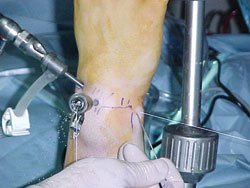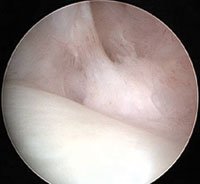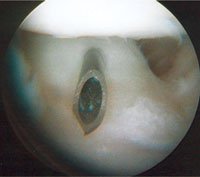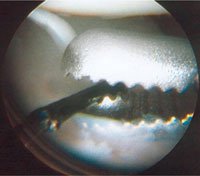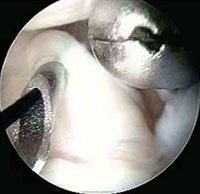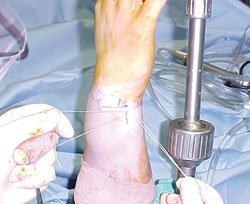High wrist scores seen with shuttle technique for TFCC repair
Using the shuttle relay technique provided excellent, long-term modified Mayo wrist scores in patients undergoing arthroscopic repair of peripheral triangular fibrocartilage complex tears, according to the results of a recently presented study.
“The technique has stood the test of time,” Michael R. Redler, MD, said during his presentation at the 2011 Annual Meeting of the Arthroscopy Association of North America.
Redler introduced the technique 12 years ago to improve the results of triangular fibrocartilage complex (TFCC) repair and began performing them regularly. “As I’ve been doing more of them, we had great success with them,” he said.
Outcomes
|
Images: Redler MR |
For the study, Redler and his colleague assessed the effects of the procedure performed on 140 patients during a 12-year period. Approximately 127 patients had greater than 2 years follow-up.
The investigators found that patients had an average postoperative modified Mayo wrist score of 94.5; scores above 90 are considered excellent. Redler highlighted that some patients had a score of 100, and none of the patients had a score of less than 80 points.
Nine patients experienced transient numbness along the dorsal cutaneous branch of the ulnar nerve, Redler noted. Early in the study, when PDS suture was used for the repair, two patients experienced irritation, requiring removal of the suture knot. Two patients developed reflex sympathetic dystrophy, and one patient had a localized wound infection through the skin because of the PDS suture knot. A 0-Vicryl suture is now used for all repairs. Redler noted that no further suture knot complications have been reported with this change.
Cost, ease of use
Redler highlighted the ease of the procedure with the shuttle relay technique.
“The ability to pass the suture through the ulnar triquetral ligament complex and the leading edge of the TFCC is easy with this technique because the shuttle relay brings the suture easily through the torn edge of the TFCC,” he said. The procedure takes 25 to 30 minutes to perform.
|
|
|
|
|
|
Redler also noted the cost-effectiveness of using the technique.
“Compared to some of the elaborate kits, it’s very cheap,” he said. “He estimated that using the procedure costs $34 for the shuttle relay, $2 to $3 for the single-strand suture and $0.85 for the spinal needle.
|
|
|
The recovery time for the procedure is short, Redler said. The patient is placed in a short-arm cast for 6 weeks postoperatively. After 2 weeks, Redler removes sutures and cast, and places the patient in a second short-arm cast for 4 additional weeks. The patients are placed in removable splints and then receive hand therapy for approximately 4 weeks. After this period, they usually can return to normal activity including sports. – by Renee Blisard
Reference:
- Redler MR, Fries SP. Arthroscopic repair of peripheral TFCC tears; long term follow up. Paper #SS-45. Presented at the 2011 Annual Meeting of the Arthroscopy Association of North America. April 14-16. San Francisco.

- Michael R. Redler, MD, can be reach at The OSM Center, 888 White Plains Rd., Trumbull, CT 06611. 203-268-2882; email: mredlermd@aol.com.
- Disclosure: Redler has no relevant financial disclosures. He receives instrument royalties from Innomed and is on the Physician Leadership Team for Surgical Care Affiliates.

